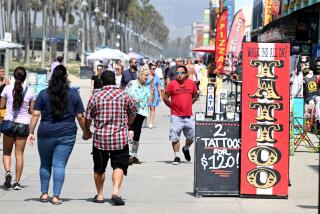As trial winds down, jurors reminded of life lost on Venice boardwalk
- Share via
The image projected in the courtroom showed Alice Gruppioni, an Italian newlywed on her honeymoon in California, smiling in a photograph taken by her husband.
As jurors turned their heads and craned their necks for a glimpse, a second photo, taken that same day, flashed onto the screen.
The photograph showed Gruppioni’s lifeless body sprawled on the concrete moments after Nathan Louis Campbell bulldozed his car into pedestrians on the Venice boardwalk, killing her and injuring 17 others, Deputy Dist. Atty. Victor Avila told jurors Monday.
After she was struck by Campbell’s car, Gruppioni was carried on the hood for 300 feet before sliding off as he drove down the walkway, Avila told jurors.
“He doesn’t stop, he never applies the brakes, and he kills her,” he said, pointing at the photo. “There is no coming back for Alice Gruppioni.”
Campbell sat expressionless, resting his forearms on the table, as Avila asked the jury to convict him in Gruppioni’s death and the injuries of others. Campbell, 39, has pleaded not guilty to murder, assault with a deadly weapon and hit-and-run charges.
Jurors have heard divergent explanations of what happened on the boardwalk on Aug. 3, 2013, during the monthlong trial.
Avila described Campbell as a man fueled by frustration and anger, intent on inflicting pain on others. After a friend’s botched effort to buy drugs, Campbell got into his Dodge Avenger and decided to jump a curb, maneuver past barriers meant to block vehicle access and purposefully plow through the packed boardwalk.
The prosecutor played a surveillance video showing Campbell walking around the boardwalk moments before he drove into the crowd. Avila argued that the footage proves Campbell knew how crowded the popular tourist destination was and pointed to surveillance footage he said showed the vehicle swerve toward two people who narrowly escaped being hit.
Avila also reminded jurors of the testimony of a homeless man, who said Campbell told him that he wanted to run down a drug dealer who ripped off his friend.
“Point them out; I’m going to run them over,” Campbell told a homeless man, Avila said.
But defense attorney James Cooper told jurors that Campbell did not plan to kill anyone and was not acting deliberately.
“Yes, my client did cause this tragic, nonsensical event,” Cooper said. “Mr Campbell is a killer. However, unintentional killings are not murder.”
Cooper told the jury that the prosecution lacked evidence that proves premeditation and relies heavily on the unreliable testimony of a homeless man. The prosecution has failed to prove that Campbell set out to kill.
“The fact that his car struck her and caused her to die is not the same as murder,” he said.
Closing arguments are expected to conclude Tuesday.
More to Read
Sign up for Essential California
The most important California stories and recommendations in your inbox every morning.
You may occasionally receive promotional content from the Los Angeles Times.











